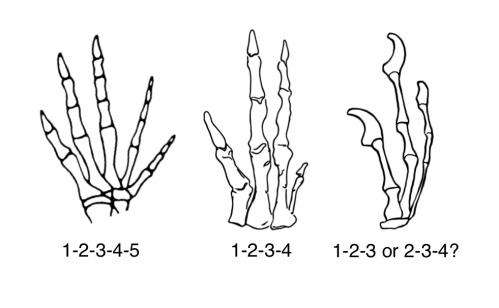The five fingers of our feathered friends: New research results on the evolution of bird wings

In most tetrapods (land vertebrates) the fourth (ring) finger is the first to develop in the embryo. And in birds, the finger on the outside of the hand (posterior, the pinky side) appears first, which suggests that this is the ring finger. However, it can be shown that on the thumb side (anterior) an embryonic finger begins to develop, but quickly disappears—this would have to be digit I. These data argue for an identification of the fully-formed fingers as the index, middle, and ring fingers (II, III, IV).
However, the three fingers of the earliest known bird—Archaeopteryx—resemble those of the dinosaur Deinonychus, with whom Archaeopteryx was probably closely related (as was the famous Velociraptor). Successive fossils show the reduction of two fingers on the posterior side of the hand in the ancestor of Deinonychus, and thus support the thumb, index, and middle finger identification (I, II, III) of the bird fingers. Also, the genes active in first bird finger correspond with those of the developing thumb in other animals, and not those of the index finger.
To resolve this contradiction, three approaches had predominated: 1) Birds do not come from dinosaurs after all; 2) the dinosaur ancestors of birds had also the three middle fingers (II, III, IV); or 3) the three anterior fingers (I, II, III) of the birds were somehow moved to the middle three embryonic positions. In fact, none of these theories can explain all the existing data.
For the birds: Thumb, index, and middle fingers are actually index, middle, and ring fingers. "The appearance—the so-called phenotype—of the fingers is determined during embryonic development by the signalling protein Sonic Hedgehog, which emantes from the posterior side of the developing limb before any fingers appear. This simply means that the concentration of this protein on the little-finger side is highest and decreases toward the future thumb. Therefore each finger precursor (the cells that will develop into the finger) adjusts its gene expression—and in consequence, its phenotype—according to the Sonic Hedgehog concentration in its immediate environment. We have devised a hypothesis based on molecular and biomechanical mechanisms that is able to explain all the available data," said lead author Daniel Capek, who conducted research in the group of Dr. Brian Metscher and Prof. Gerd Müller in the Department for Theoretical Biology at the University of Vienna for this project and is currently a Ph.D. student at IST Austria.
According to this hypothesis, a posterior reduction in dinosaur evolution actually proceeded with the little finger being reduced and then lost, and the ring finger was partially reduced. However, it is generally much easier to reduce the outer fingers than the more central ones, as they appear later in development. Thus the first finger is reduced ("thumbs down") instead of the fourth finger, leaving an anterior area open for the early precursors of the other fingers to grow into. This would lead those developing fingers to encounter an anterior-like Sonic Hedgehog concentration and then to develop accordingly—more like I, II, and III.
"This mechanism explains why the fingers of Archaeopteryx and modern birds have the shapes of the anterior fingers (I, II, III), even though they are actually the central fingers (II, III, IV). At the same time, this hypothesis is consistent with the fossil findings and matches the current developmental genetics results," says Brian Metscher of the Department of Theoretical Biology at the University of Vienna.
More information: Publication in Journal of Experimental Zoology: Čapek, D., Metscher, B. D., and Müller, G. B.: Thumbs Down: A Molecular-Morphogenetic Approach to Avian Digit Homology. Journal of Experimental Zoology Part B (Molecular and Developmental Evolution), December 2013. DOI: 10.1002/jez.b.22545
Provided by University of Vienna

















